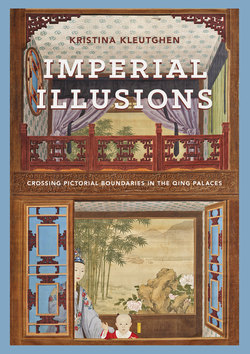Читать книгу Imperial Illusions - Kristina Kleutghen - Страница 37
На сайте Литреса книга снята с продажи.
ОглавлениеAs the primary mode of decoration in medieval Buddhist temples and cave grottoes, murals visualized the narratives and events described in sutras as ways to achieve enlightenment, and presented detailed visions of accessible afterlife paradises populated by seemingly three-dimensional deities. Buddhism, with its practices of conflating reality and illusion, reconciling the existence of multiple worlds, and a fundamental doctrine of trying to escape reincarnation, inherently relies on “vision, optics, phantasmagoria, and meditation, and readily dissolves the cognitive boundaries between the observer and the observed.”8 Extant medieval Buddhist murals, most notably those on the plastered rock walls of the temple grottoes at Dunhuang’s Mogao Caves preserve the traces of three-dimensional illusionism in early Chinese murals. Located at an eastern oasis of the Taklamakan desert, Dunhuang was a major pilgrimage site and stopping point for trade caravans, and from the fourth through fourteenth centuries it benefited from the blend of Chinese, Indian, Tibetan, and Central Asian painting styles brought by the many artists who arrived there alongside travelers and pilgrims. To lend convincingly three- dimensional skin, muscle, and animation to Buddhist deities, artists utilized the Indian “flush-tinted” (yunran) or “convex and concave method” (aotufa) painting techniques of layering flesh-toned lines and colors.9 By using rosy-toned pigments instead of black ink to outline the figures, and adding highlights to their limbs and faces, these murals suggested three-dimensional beings rather than flat figures depicted on a flat surface. The fleshy, rounded appearance of these figures is commonly thought to have originated with Buddhism outside of China, both the religion and the representational technique still retaining something of their foreign import during this early period.
Building on the deceptively sculptural effects of these painting techniques, the Dunhuang artists often presented the Buddha and his entourage in architectural environments that suggested deep horizontal recession, and therefore real three-dimensional spaces contiguous with the viewer’s own space. On the south wall of an eighth-century cave, for example, a representation of a three-dimensional recessed niche populated by the Buddha and his attendants was placed in the center of a two-dimensional landscape (figure 1.1). Appearing to have burst through a more flatly rendered painting of figures in landscape, the niche portion of the painting creates the illusion that the viewer is having a direct encounter with the Buddha.10 This impression is amplified by a viewer’s general desire for their animation that is inherent in all illusionistic paintings of figures regardless of where they are produced,11 as well as by the specific Chinese belief that salvation by a Buddhist deity was entirely possible in the real world. In Buddhist murals like this one, such lifelike deities might therefore appear poised to offer the viewer salvation from the burden of reincarnation, whereas visibly painted figures, as in the background landscape, could not. The sudden juxtaposition of two- and three-dimensional treatments in this mural strengthens the illusionism of the central niche scene, the space of which seems to recede horizontally backwards away from the viewer while the surrounding landscape recedes vertically up the plane of the wall in the more linear Chinese mode. Such abrupt contrasts
